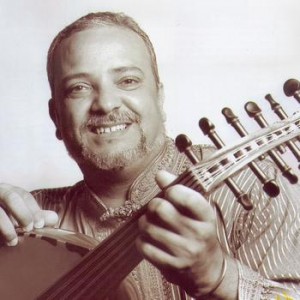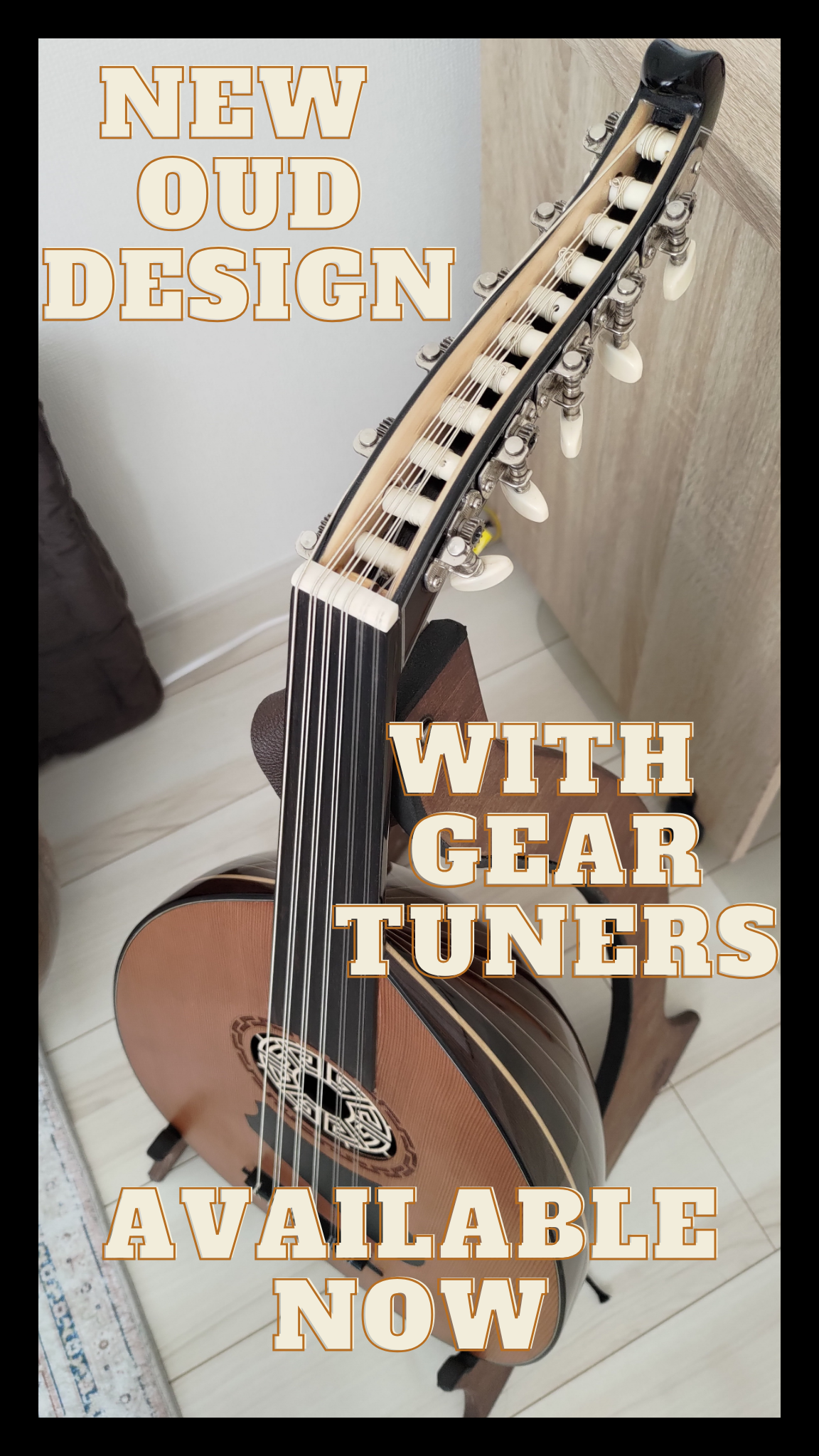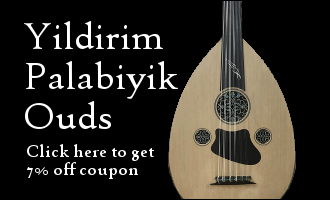Some of you said in our survey that you would like to know “what combination of technique, knowledge and execution it takes to emulate the great masters.”
Well, let’s get familiar with some big names. In the next few
months, I will write a series of articles discussing “celebrity Oud styles” and reviewing albums. Today, I want to discuss one of my favorite albums,  Said Chraibi’s Oud. After reading this article, you’ll be able to see what maqams are being used for some tracks, I’ll tell you what modulations are happening in one of his long taqsims as well. You’ll gain a better understanding on what happens during a taqsim, and you’ll learn a little secret about modulations.
Said Chraibi’s Oud. After reading this article, you’ll be able to see what maqams are being used for some tracks, I’ll tell you what modulations are happening in one of his long taqsims as well. You’ll gain a better understanding on what happens during a taqsim, and you’ll learn a little secret about modulations.
How I Heard of Said Chraibi
Said Chraibi’s Oud playing was maybe the third Oud player I had really heard. It was sometime in the late 1990’s, and a friend let me borrow a CD from the Fez Festival in Morocco. I can’t tell you how many times I’ve listened to his track on that CD. It blew my mind, I knew that I wanted to play like that.
Said Chraibi of Morocco has always been my favorite Oud player. His playing style is intricate, expressive, and exotic. It is a fascinating style because you can really hear the african tradition blending with Arabic tradition. If you want to hear the origins of blues music, I think this is an important album to listen to because you can hear the hints of it here and there (see track 1). Chraibi’s ornamentation is unique. I’ve really never heard another Oud player like him.
Style
Said Chraibi uses tuning FF AA DD gg cc ff on this album. This tuning is unique, and is probably why his Oud always stood out from other Oud players later on. This tuning has been criticised because if your technique is not developed properly it can make you lazy, because it increases the range of the Oud so you can keep your hand in one position and still reach the upper notes.
Chraibi’s playing is quite heavy handed. His risha technique is uncompromising. It sounds as though his hand just plows through the strings. He plays a lot of running phrases that go up and down the scales with consecutive risha down and up strokes. He has a particular slide to his playing too.
This is a very important yet subtle fact to remember about Chraibi’s playing: he plays the 4th note in Rast Maqam a bit flatter than just intonation. For example, occasionally he plays Rast from F, so he plays Bb just a little flatter than one might expect him to play. Keep in mind this is purposeful. It adds so much expressiveness to his playing.
The Album
Track 1
Souleimane
This is another rendition of the same taqsim and piece that Chraibi played on the Fez Festival CD. It starts with a Taqsim which is in Maqam Nakriz starting in “C”, but there is a modulation sometimes which utilizes F natural as opposed to an F sharp. I don’t know what this is called. He also modulates into Rast and Nairuz later in the piece. This song is in a slower 7 rhythm that I would divide up as 3+4. I remember when I first heard this rhythm, I couldn’t keep up with it at all. Chraibi also likes to play in and out of rhythm, bending time, and then jumping back in effortlessly.
0:52 Modulation to something close to Maqam Saba Zamzam This part gives the African sound that I mentioned above. Sounds close to a pentatonic scale.
3:10 Running phrases
3:55 Rast in C, makes a quick reference to Hijaz starting on G.
As you’ll see, he loves to change from one Maqam to another very quickly, but he does it with a lot of charm.
Track 2
Taksim Sur Le Makam Awjara
This is the craziest Maqam I’ve ever heard before… I only ever seen it on this album. It’s really weird. I’ll try to show you what it looks like.
E F G A# B C D# E
E sounds like the starting point, but often C is used to begin the melody and rests on E. It may seem very difficult to play, but it is deceiving. Your first three fingers can just stay in one position with your middle finger on E and you can reach all the notes.
In this Maqam, it sounds like he likes to descend the scale with a A natural sometimes. This could be a modulation as well.
After playing in the upper range, he descends the scale using A natural, then modulates to Aqb from G. I wouldn’t want to speculate what this would be called. In fact, this brings up an important point for really understanding modulations.
Have a listen!
The Little Secret
When modulations occurs the new maqam being played is NOT ALWAYS played in its entirety… sometimes only one note of the new maqam is heard before returning to the original maqam. Remember this because it is important not to look at Maqams as “scales”, as we do in Western music. Look at them as bundles of 2 to 5 notes that convey different colors, and different shades. These bundles of notes can be joined together to create what LOOKS like a scale. I speculate that that what we know today as a “maqam” is really someone’s method of playing a particular melody that became tradition over time. There are really an infinite number of possible combinations, but don’t let that deter you.
In the Oud for Guitarists Complete & Fast Track Packages, you will receive easy-to-read Oud Maqam Fingerboard Diagrams for 9 most popular maqams, so you can visually learn notes on the fingerboard and start playing maqams right away.
If you want to read about how a new maqam was created more recently check out my article about on my other blog:
http://www.majnuunmusicanddance.com/maqam-daad-o-bidaad-understand-persian-music/
Now back to the album…
Track 3
Sama’i Awjara Ghouzoud
A Sama’i based on the Maqam described above. Rhythm is 10/8.
Track 4
Taksim Sur Le Makam Hijaz Kar Kurd
This is a taqsim in Hijaz Kar Kurd. This Taqsim moves from Hijaz Kar Kurd on C to many different Maqams and always returns to Hijaz Kar Kurd. Take a look at this list and follow along.
Begin: Hijaz Kar Kurd on C
1:50 Hijaz on F
2:03 Suznak on F
2:32 Hijaz Kar Kurd C
3:52 Bayati on G
5:03 Hijaz Kar Kurd C
5:45 Upper octave Hijaz Kar Kurd
7:00 Plays with the feeling of Nahawand on F, but it’s probably still Hijaz Kar Kurd
7:30 Rast and Suznak on F
8:30 Bayati on G
9:00 Hijaz Kar Kurd
9:18 Very cool modulation. At first it sounds like Ajam on C, but descends the scale with Eb.
10:08 Kurd on C
10:49 Rast and Suznak on F
End with Hijaz Kar Kurd on C
Track 5
Pensees Andalouses
This is a great example of Andalusian Oud playing. In fact Said Chraibi is probably one of the best examples of Andalusian Oud playing. This style is very chromatic, and there are many accidentals. You can hear East meets West in these melodies.
Track 6
Likaa
This piece is exquisite. It flows in and out of major and minor scales. It’s not quite like Hijaz although, the Hijaz tetrachord in there.
Track 7
Taksim Sur Le Makam Raast Danjikah
This taqsim is definitely in Rast from F, but it is somewhat unusual. I would have to look at this track more to understand it better.
Track 8
Ya Ommou Abaya
Another favorite track of mine. This piece is in Maqam Suznak and Nairuz. Listen to the phraseology in this piece, this is very characteristic of Chraibi.
Track 9
Longa Nakryse
A longa in Nakriz. It is in 2/4 Rhythm and changes from Ayyub to Malfuf a lot.
Track 10
Nouzha
I’ve been practicing this piece for a long time off and on, and learning it was how I figured out that Chraibi is using the high ff tuning. The two finger chords in this piece are challenging to play with standard tuning, but would be easier with high ff strings. Also, he gets a clear ringing high F harmonic which is only possible if your open string is tuned to F. Aha! Nevertheless, it is a real workout to play this song in standard tuning.
This piece is in Ajam on F, and modulates to what I think is Nakriz on Bb. Nakriz on Bb makes the Hijaz tetrachord fall on notes C D# E F.
Track 11
Improvisation Autour de Souleimane
This is a rehashing of the main Souleimane theme as a free style improvisation.
How to Find Said Chraibi’s Albums
Some of Said Chraibi’s albums are on Amazon music. I would really recommend becoming acquainted with his Oud playing. By far my favorite player. Also check out this website for more information about Said Chraibi, his albums, and some more youtube suggestions.
I do hope this article has helped you see deeper into what is happening in Chraibi’s playing. It is very complex, and I’m sorry I didn’t have time to get into details with all the tracks. But now if you pick up the album and you listen to it, you can use this as a guide so you can follow along with it, and gain more appreciation for what is happening in the music.
If you have any suggestions on alternate Maqams, or any insights, please leave a comment below. If you liked this article and think it will help others, by all means, share it like CRAZY.






Hi Navid,
I think the makam used in track 2, “Awjara” is similar to the Turkish makam Evcara. The scales are very similar as is the pathway in my opinion.
Here is a taksim in Evcara, played on Kanun.
https://www.youtube.com/watch?v=y6-6GdfEAjM
Bill
Hi Bill,
Thanks for the information, that sounds like the one! It’s very haunting. Love it.
What is the title of the album? I can’t seem to find it in the article and want to purchase it.
The title is “Ud”. I spelled it wrong. Here is a link: http://www.allmusic.com/album/ud-mw0000236333.